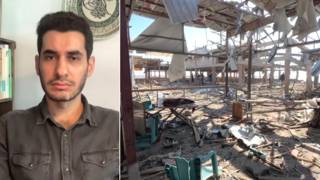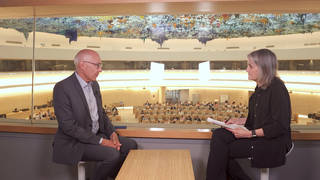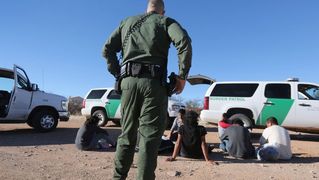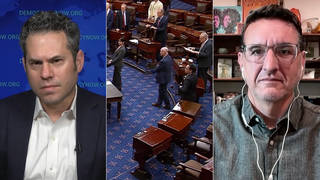
As 14 states and more than 130 cities across the U.S. celebrate Indigenous Peoples’ Day in place of Columbus Day, we go to Arizona, where Indigenous communities are leading resistance against the construction of the U.S.-Mexico border wall near a sacred spring inside the Organ Pipe Cactus National Monument. People’s “lives have been so severely impacted by not only this border wall, but the complete militarization of our homelands due to this irrational fear of folks on the other side, which are our relatives,” says Nellie Jo David, an O’odham water and land defender. This campaign of nonviolent protests comes as a federal appeals court issued an order Friday to halt the border wall construction in some areas of Arizona, along with Texas, New Mexico and California.
Transcript
AMY GOODMAN: This is Democracy Now!, democracynow.org, The Quarantine Report. I’m Amy Goodman.
Fourteen states and more than 130 cities across the United States are celebrating Indigenous Peoples’ Day today in place of or in addition to Columbus Day, as the myth of Columbus as beneficent discoverer is debunked, as he’s talked about an oppressive colonizer. The holiday comes amidst a growing call to remove monuments to Columbus, along with Confederate generals. It also offers a chance to recognize the critical role of Indigenous people in protecting the planet.
So we spend the rest of the hour in Arizona looking at how O’odham land and water defenders are leading a campaign against the construction of the U.S.-Mexico border wall near a sacred spring inside the Organ Pipe National Monument. The federal government has blocked road access to the sacred spring, where contractors have been pumping millions of gallons of groundwater to make cement for the wall. In August, activists temporarily blocked access to a site where 30-foot steel barriers were being assembled for use in the wall.
LAND AND WATER DEFENDERS: No border, no wall! No border, no wall! No border, no wall! No border, no wall! No border, no wall! No border, no wall!
AMY GOODMAN: This campaign of nonviolent protests comes as a federal appeals court issued an order Friday to halt the border wall construction in Arizona, along with Texas, New Mexico and California, in response to a lawsuit filed by the Sierra Club, along with multiple states and other groups. The 9th U.S. Circuit Court of Appeals said the Trump administration violated the Constitution when it tried to pay for the construction using $3.6 billion that Congress had authorized for the military.
For more, we go to Tucson, Arizona, where we’re joined by Nellie Jo David, an O’odham water and land defender who was arrested last month on Hia C-ed O’odham traditional homeland when protesting near the construction site of the U.S.-Mexico border wall in Organ Pipe Cactus National Monument.
Nellie, welcome to Democracy Now! Can you explain what’s happening there and the significance of this court decision?
NELLIE JO DAVID: Well, thank you, Amy.
Yeah, it’s been a pretty tumultuous road. Our lands have been under militarization by Border Patrol, by occupying entities, pretty much my entire life. And so, this is just another episode in which we have just been under complete militarization from these entities. And now it’s including these companies that are putting in man camps where I’m from, Ajo, Arizona.
And for them to be constructing during this time of COVID is especially troubling for us. We’re dealing with our own problems, on top of the fact that they’re desecrating our sacred sites in the area of Quitobaquito Springs, in the area of Monument Hill and then beyond, in many areas, in Cabeza Prieta Wildlife Refuge and also the Barry Goldwater bombing range. So, all of these areas of land are occupied and, you know, are our ancestral Indigenous territory.
And so, we’ve been engaged since construction — while construction started in August, in trying to stop the border wall. And recently, you know, it just came under — it came to a place where we could no longer — we could no longer watch this without doing something drastic. And in our case, we stood in front of bulldozers, and I ended up sitting in the bucket of a bulldozer and ended up getting arrested for that.
AMY GOODMAN: When was that?
NELLIE JO DAVID: That was about a month ago, on September 9th.
AMY GOODMAN: Explain who the Tohono O’odham are, who you are, and the Indigenous people who live in this area, and where the land stretches.
NELLIE JO DAVID: Yes, I would love to. So, it’s a pretty large landscape. You know, the Tohono O’odham Reservation is roughly the shape of Connecticut. But that’s not — that doesn’t confine the area where we’re originally from. Originally, our traditional landscapes extends as far north to what’s now known as the Gila River and Salt River reservations in the Scottsdale-Phoenix area, all the way west towards Yuma, and all the way south towards the Caborca area in Mexico, and all the way east to the San Pedro River, where I’m currently located, in Tucson. So, this is a pretty large landscape.
And our people and our heritage doesn’t really know borders. I mean, it doesn’t know borders. We have O’odham in Mexico. I personally have family in Mexico. And so, with these borders that are crossing our territorial homelands, it has impacted us in pretty much every way that it could impact us.
AMY GOODMAN: Can you talk about what happened when you were arrested? How were you treated?
NELLIE JO DAVID: Oh, man. It was a very difficult experience. We were out there early in the morning. We had not intended to do what we did that day, but felt compelled to, given the desecration that was happening. And so, we were out there in the heat for a good two hours, holding off the — holding off the construction from happening, until they arrested us.
And then, once we were arrested, we were handcuffed and taken to Lukeville, where we were fingerprinted and processed. And from there, we didn’t know what was going to happen to us. We thought we were going to be taken to Ajo, which was, you know, local jail, about 45 minutes from Lukeville, which is at the port of entry. And so, that’s where we thought we were going, but they ended up taking us past Ajo for a few-more-hour drive, and we ended up going all the way to a Florence facility, also known as CoreCivic. And so, from there, it was a really confusing and scary moment for us, or two days, because we spent two days there.
So, from the moment we got there, we were kind of treated as if we were dangerous individuals. We were chained and handcuffed to our waist and around our feet. Reminded me of all the Operation Streamline proceedings that we witness here in Tucson. They happen every single day. And so, we were chained. We were not told what was happening. We asked for lawyers. We were not allowed to speak to one ’til the next day. We asked for phone calls. We were not given a phone call.
And it took a lot of time for them to actually process us. So, from going to that extreme heat in the Arizona desert to the extreme cold of the CoreCivic facility, we weren’t feeling too great at that point. And it got to be pretty late into the night until we were actually processed. And then, after we were processed —
AMY GOODMAN: Did they ask you your citizenship status, Nellie?
NELLIE JO DAVID: I don’t remember. I don’t think that they did. Yeah, I think that they might have known that we were not — that we had citizenship on this side.
AMY GOODMAN: And can you talk about what this wall has meant and the effect on the environment, as well? I mean, Democracy Now! was out there covering this area. We saw and have since seen some of the destruction. And what it means for ceremonies and for the environment?
NELLIE JO DAVID: Yeah, the destruction has been devastating. Since August a year ago, or over a year ago, we’ve seen this violation. The Ha:sañ, the saguaro cactus, in our O’odham stories, we view them as people. And so, to watch them be uprooted from their locations where they’re at and then just pretty much left there to die, many of them — you know, the Border Patrol or construction or whoever’s the entity, as a spokespeople, were claiming that they were not killing the saguaro cactus, but they were killing very many of them. We saw them just kind of carelessly thrown on the side, which they were later picked up. There was all kinds of wilderness that just had to be removed for just the access roads. There’s a 30-foot access road. And so, all of that was killed and violated, and so that was one of the first violations.
And then we saw Monument Hill being blown up, in a big show of might, while the Tohono O’odham chairman was in Washington, D.C. And also, you know, so there’s so many sites that have been impacted. It’s a very large stretch of land. And then Quitobaquito Spring is the most recent one that’s been desecrated. And it is a very vital source of water in the middle of a very dry desert. You know, this is a corridor where Prevention Through Deterrence is used to target migrants that are coming through, because it is known by authorities that water is such a precious resource that folks coming through, if they don’t have that water, animals coming through — all, pretty much, wildlife, if they don’t have that water, that means the end of the life cycle. So, that’s what Quitobaquito Springs means to us. It’s the source of life. It’s the source of so much for people, for plants, for desert fauna and pretty much all life surrounding that.
And so, since border wall construction began, drillers have come and pretty much set up all around the area and have been drilling groundwater for the roads and, as well, in addition to mixing concrete to hold the steel barriers. And so, pretty much all year we’ve been watching Quitobaquito Springs and how its water source has been depleted. The rate in which the flow comes from — it comes from a mountain. It comes out of a mountain and into a man-built oasis, where the water is kept. But, you know, it’s a natural spring. And that natural flow has been very much impacted by all of that drilling.
In addition to these huge lights in the area — we have some of the most beautiful views of the stars around. And those bright lights are also affecting all of the animals. There’s bird migrations. It’s a very important animal and bird migratory habitat. And just last year, we saw many footprints from, you know, what we know as Mexico coming into Quitobaquito Springs, and because there is a border wall barrier, all of these animals who are coming on foot, even animals or birds that have low flying power, cannot access the springs. And so, we fear and we worry that the border wall will cause extinction for many of these animals, including the Sonoran pronghorn, if it loses its water source in the area. There’s the Sonoran mud turtle. There’s the Quitobaquito pupfish. And so, there’s all of this life that we’re watching — we’re watching before our eyes as it’s all harmed.
And so, it’s been a very scary and very devastating thing for us. And it’s also our heritage. We had ancestors that lived at the spring. Amber Ortega, who was arrested with me, is a direct descendant of people that lived — Hia C-ed O’odham that lived at Quitobaquito Springs. And so, surrounding the entire area, we had villages. We had all these connections. Sonoita is a nearby border community.
AMY GOODMAN: Nellie Jo David, as we come to the end of this discussion, on this Indigenous Peoples’ Day, can you talk about the solidarity across Indigenous communities in the borderlands against the wall, including the Kumeyaay people of California?
NELLIE JO DAVID: Yes. We are in solidarity of Kumeyaay and Carrizo/Comecrudo, Lipan Apache and all border Indigenous peoples whose lives have been so severely impacted by not only this border wall, but the complete militarization of our homelands due to this irrational fear of, you know, folks on the other side, which are our relatives. And so, other tribes, other Indigenous people along the border feel that pain of being disconnected, of having a border cross us. And so, you know, we definitely stand in solidarity. Many of us who have been taking actions against the construction have gone to other places, such as the Carrizo/Comecrudo area in Texas and also the Kumeyaay lands that now occupy California. And we stood in solidarity.
AMY GOODMAN: And will this ruling — will this ruling stop the building of the wall, with a federal court saying no to diverting military funds into the southern border wall?
NELLIE JO DAVID: Well, I certainly hope so, and it should. You know, I’m almost very — I’m very skeptical of things like that. Last June —
AMY GOODMAN: We have 20 seconds.
NELLIE JO DAVID: OK. Well, last year, we were told that we had time, and then the Supreme Court issued a stay, and it was lifted, and we no longer have that. So, I hope so. But in the meantime, actions are still going to take place in which we will fight the border wall, we will fight militarization, we will fight the desecration of our homelands.
AMY GOODMAN: Nellie Jo David, I thank you so much for being with us, a Tohono O’odham water and land defender, part of the ongoing nonviolent protests against the construction of the U.S.-Mexico border wall in the Organ Pipe Cactus National Monument.
That does it for our broadcast. I’m Amy Goodman. Stay safe. Wear a mask.













Media Options